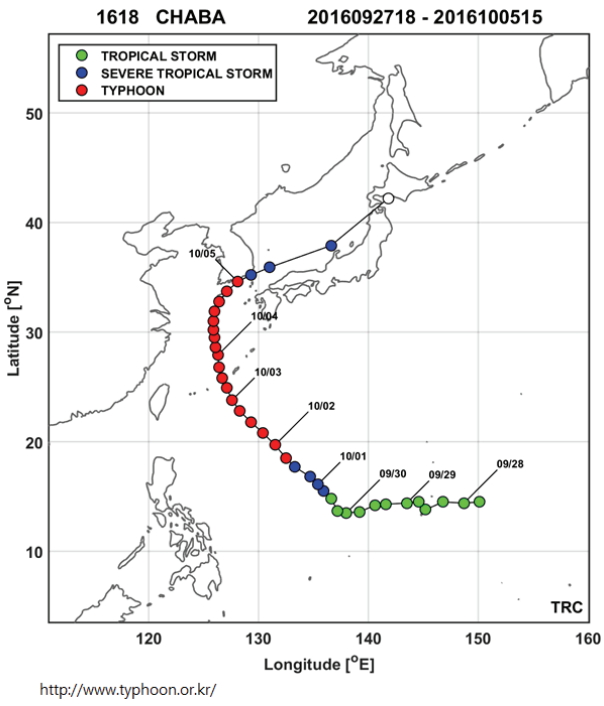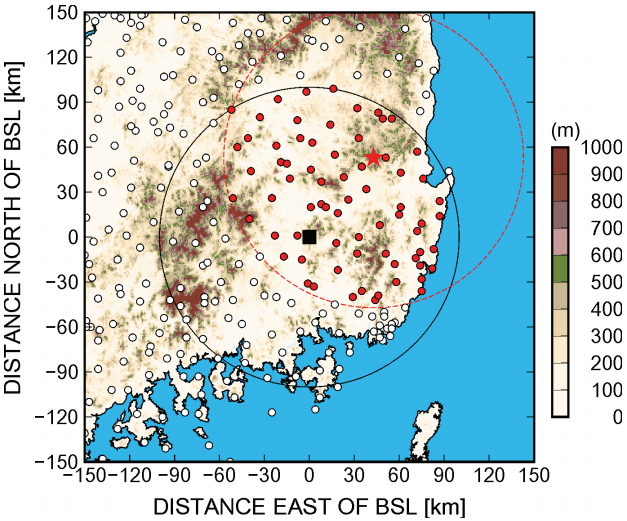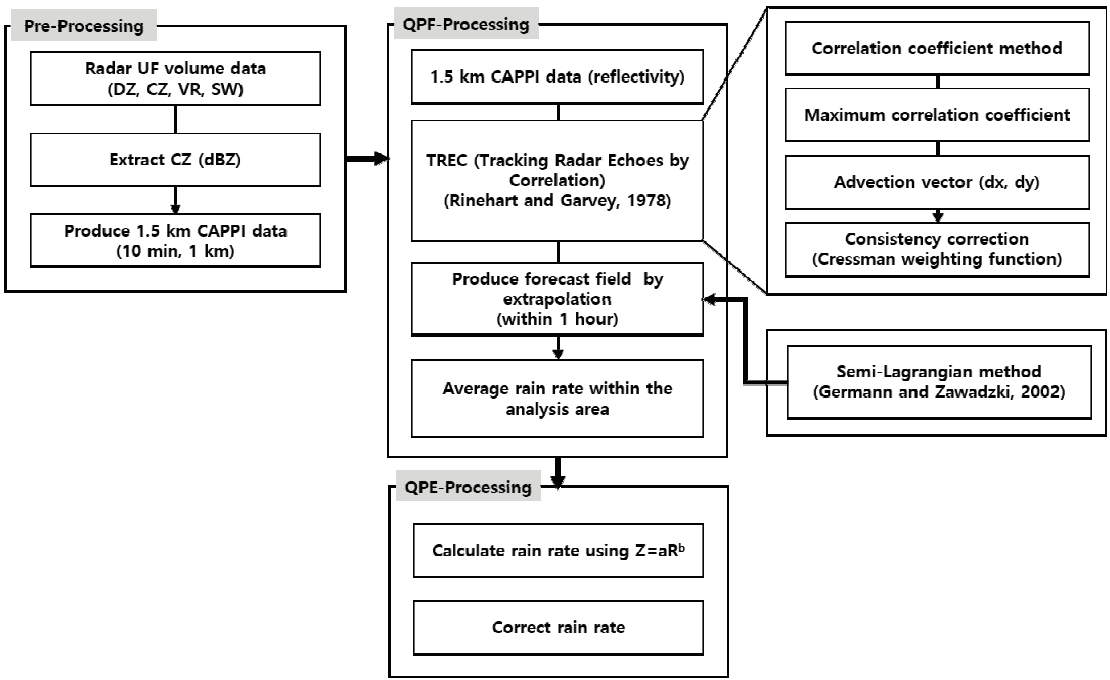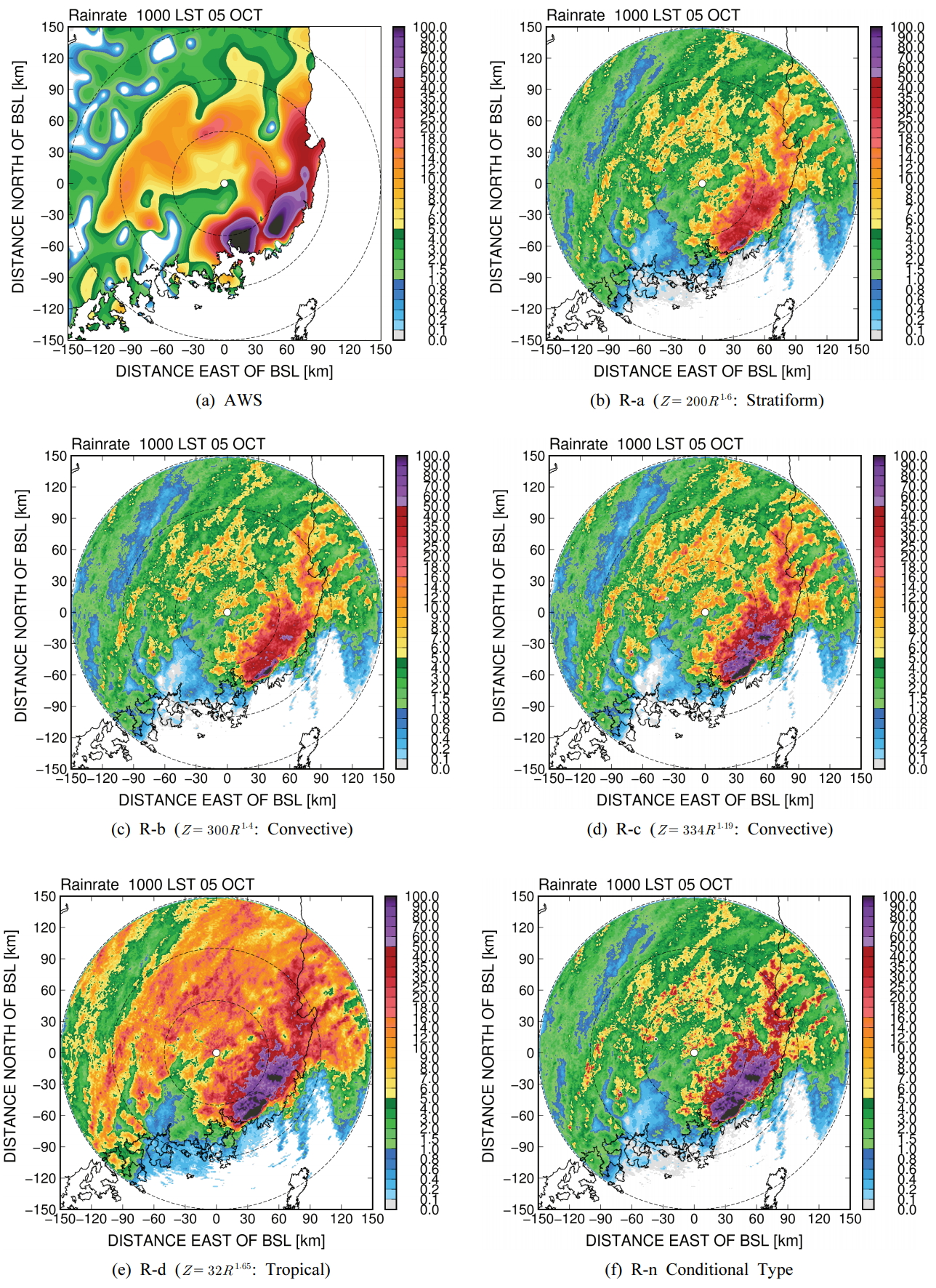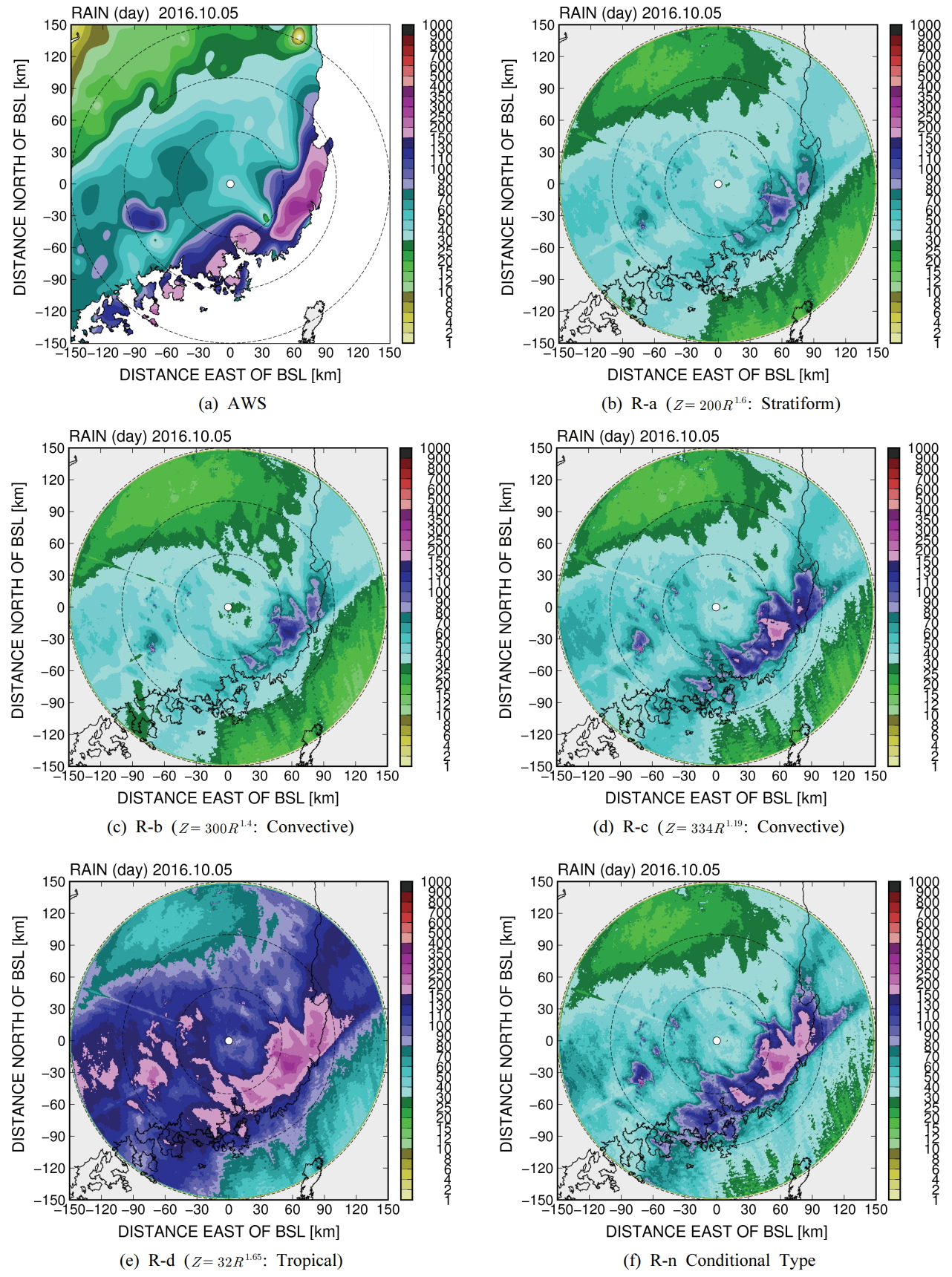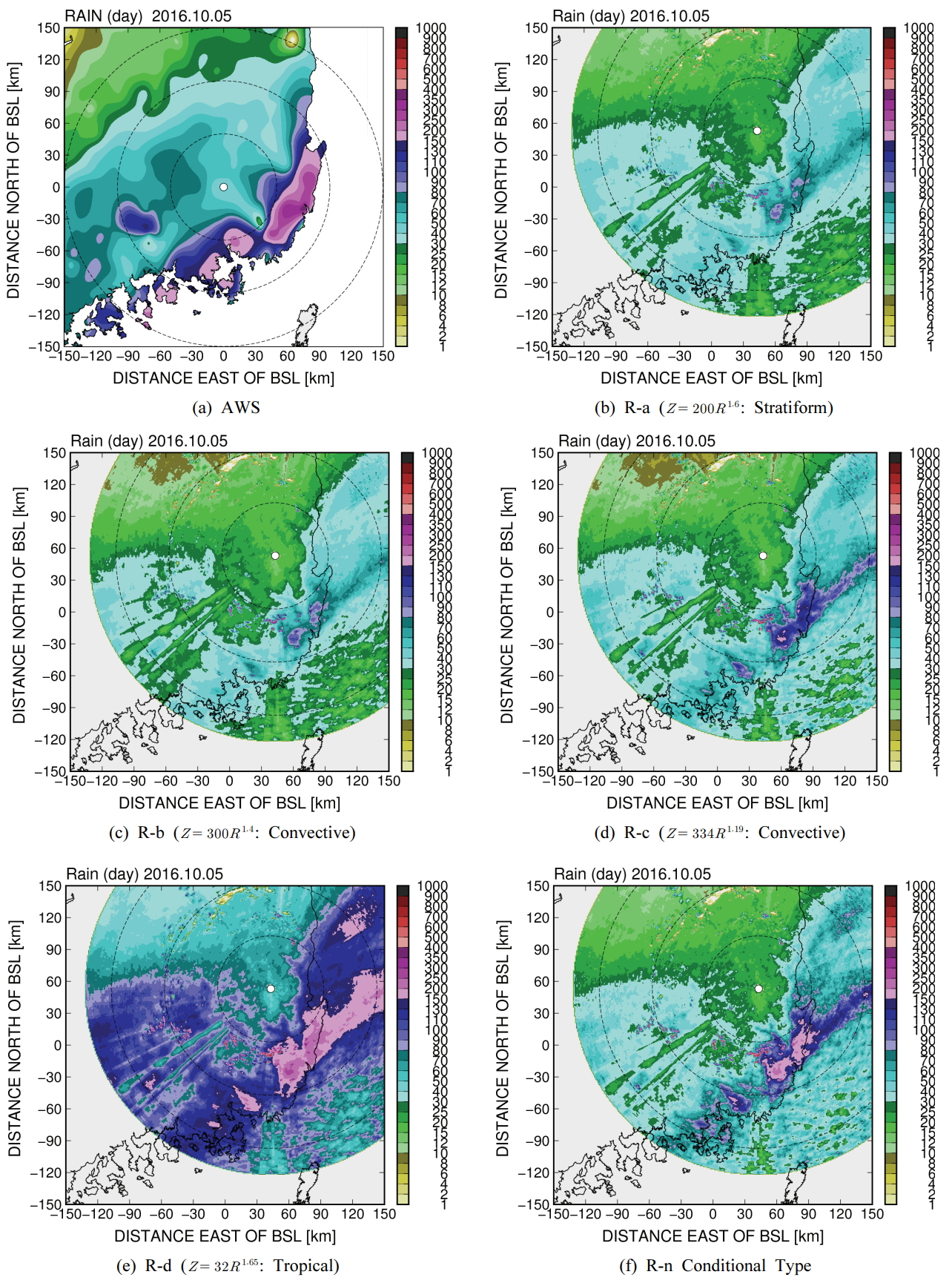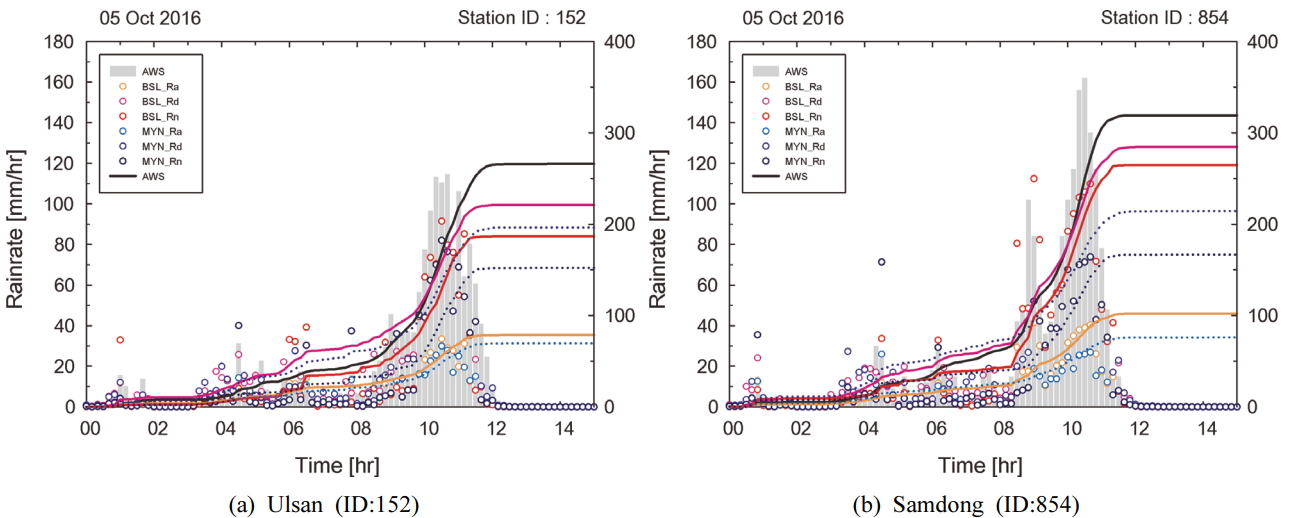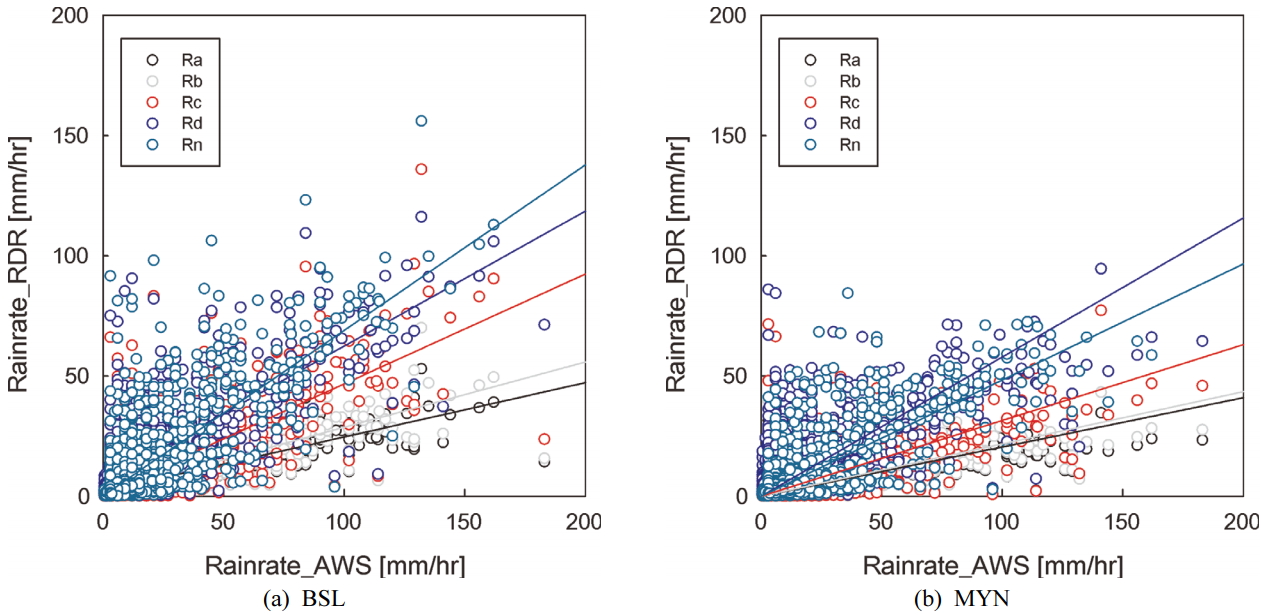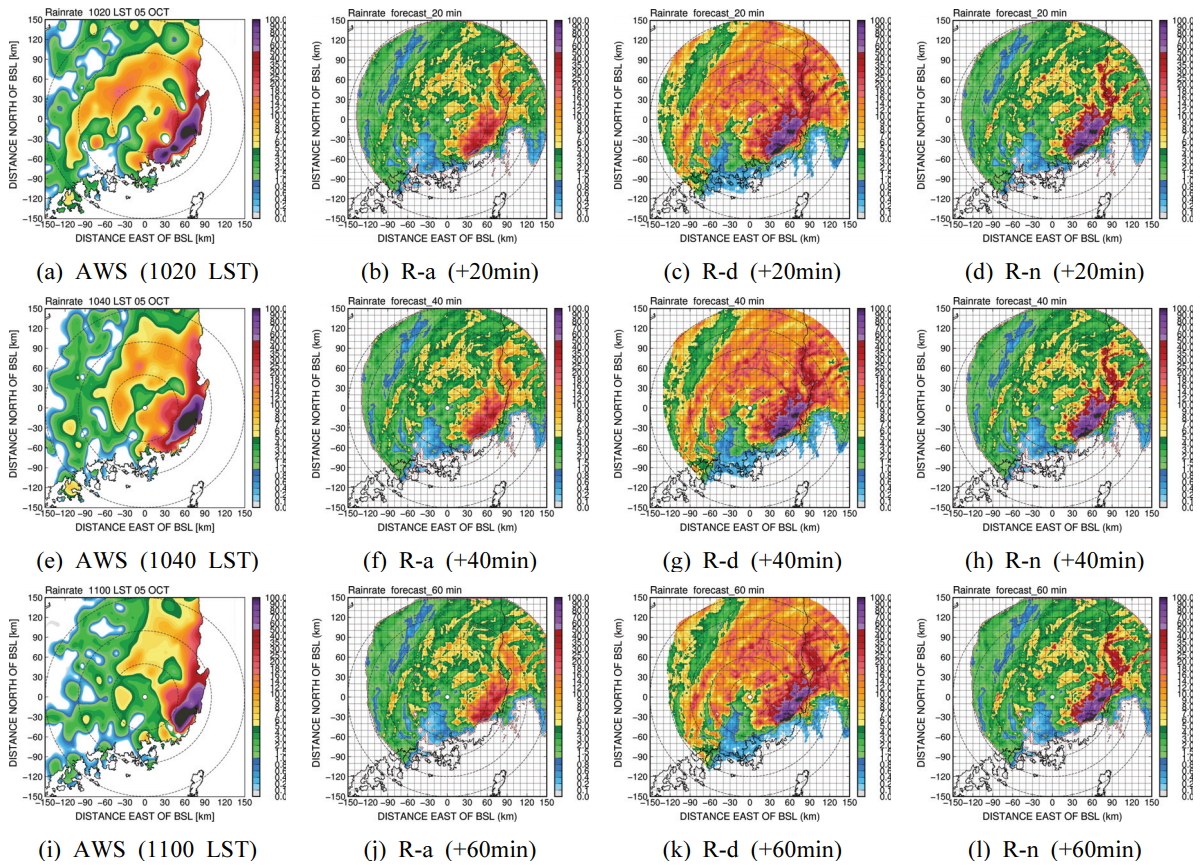Atlas, D., Ulbrich, C., Marks, F.D. Jr., Amitai, E., and Williams, C.R. (1999) Systematic Variation of Drop Size and Radar-rainfall Relations.
J. Geophys. Res. Atmos., Vol. 104, No. D6, pp. 6155-6169.


Blanchard, D.C. (1953) Raindrop Size-Distribution in Hawaiian Rains.
J. Meteor., Vol. 10, pp. 457-473.

Borga, M., Anagnostou, E.N., and Frank, E. (2000) On the Use of Real-time Radar Rainfall Estimates for Flood Prediction in Mountainous Basins.
J. Geophys. Res. Atmos., Vol. 105, No. D2, pp. 2269-2280.


Calheiros, R.V., and Zawadzki, I. (1987) Reflectivity-rain Rate Relationships for Radar Hydrology in Brazil.
J. Appl. Meteorol. Climatol., Vol. 26, pp. 118-132.

Cha, J.W., Lee, J.K., Park, H.S., Park, J.S., and Kim, K.H. (2013). Improvement of the Radar-AWS Rain rate Calculation System Using the Local Gauge Correction (LGC) method. Proceedings of the 2013 Spring Meeting of Korea Meteorological Society. pp. 104-105 (in Korean).

Cressman, G.P. (1959) An Operational Objective Analysis System.
Mon. Weather Rev., Vol. 87, No. 10, pp. 367-374.

Fulton, R.A., Breidenbach, J.P., Seo, D.J., Miller, D.A., and O'Bannon, T. (1998) The WSR-88D Rainfall Algorithm.
Weather Forecast., Vol. 13, No. 2, pp. 377-395.

Germann, U., and Zawadzki, I. (2002) Scale-Dependence of the Predictability of Precipitation from Continental Radar Images. Part I: Description of the Methodology.
Mon. Weather Rev., Vol. 130, No. 12, pp. 2859-2873.

Gochis, D., Schumacher, R., Friedrich, K., Doesken, N., Kelsch, M., Sun, J., Ikeda, K., Lindsey, D.T., et al (2015) The Great Colorado Flood of September 2013.
Bull. Am. Meteorol. Soc., Vol. 96, No. 9, pp. 1461-1487.

Jang, S.M., Park, K.W., and Yoon, S.K. (2016) A Multi-sensor based Very Short-term Rainfall Forecasting using Radar and Satellite Data: A Case Study of the Busan and Gyeongnam Extreme Rainfall in August, 2014.
Korean J. Remote Sens., Vol. 32, No. 2, pp. 155-169 (in Korean).


Jones, D.M.A. (1956).
Rainfall Drop Size Distribution and Radar Reflectivity. Research Report, No. 6, U.S. Army Contract DA-36-039 SC-64723, Illinois State Water Survey, Urbanba. pp. 1-20.

Joss, J., and Waldvogel, A. (1970). A Method to Improve the Accuracy of Radar Measured Amounts of Precipitation. 14th Radar Meteorology Conference. Tucsan, Arizona: American Meteorological Society; pp. 237-238.

Jung, S.H., Kim, K.E., and Ha, K.J. (2005) Real-time Estimation of Improved Radar Rainfall Intensity using Rainfall Intensity Measured by Rain Gauges.
J. Kor. Meteor. Soc., Vol. 41, pp. 751-762 (in Korean).

Kato, A., Maki, M., Iwanami, K., Misumi, R., and Maesaka, T. (2009) Nowcasting of Precipitation Based on Complementary Application of X-band Polarimetric Radar and C-band Conventional Radar J.
Japan Soc. Hydrol. and Water Resour., Vol. 22, No. 5, pp. 372-385.

Kim, G.S., and Kim, J.P. (2009) Development of a Short-term Rainfall Forecast Model Using Sequential CAPPI Data.
J. Korean Soc. Civ. Eng., Vol. 29, No. 6B, pp. 543-550 (in Korean).

Kim, J.P., Yoon, S.K., Kim, G.S., and Moon, Y.I. (2015) Aplication of Very Short-Term Rainfal Forecasting to Urban Water Simulation using TREC Method.
J. Korea Water Resour. Asoc., Vol. 48, No. 5, pp. 409-423 (in Korean).


Kim, K.H., Kim, M.S., Lee, G.W., Kang, D.H., and Kwon, B.H. (2013) The Adjustment of Radar Precipitation Estimation Based on the Kriging Method.
J. Korean Earth Sci. Soc., Vol. 34, No. 1, pp. 13-27 (in Korean).


Kim, K.H., Lee, G.W., Kang, D.H., Kwon, B.H., and Han, K.Y. (2014) Adjustment of Radar Precipitation Estimation Based on the Local Gauge Correction Method.
J. Korean Earth Sci. Soc., Vol. 35, No. 2, pp. 115-130 (in Korean).


Kitchen, M., and Blackall, R.M. (1992) Representativeness Errors in Comparisons Between Radar and Gauge Measurements of Rainfall.
J. Hydrol., Vol. 134, No. 1-4, pp. 13-33.

Lee, J.K., Kim, J.H., Park, H.S., and Suk, M.K. (2014) Development of Radar-Based Multi-Sensor Quantitative Precipitation Estimation Technique.
Atmosphere, Korean Meteorological Society. Vol. 24, No. 3, pp. 433-444 (in Korean).


Marshall, J.S., and Palmer, W.McK. (1948) The Distribution of Raindrops with Size.
J. Meteor., Vol. 5, No. 4, pp. 165-166.

Morin, E., Maddox, R.A., Goodrich, D.C., and Sorooshian, S. (2005) Radar Z-R Relationship for Summer Monsoon Storms in Arizona.
Weather Forecast., Vol. 20, No. 4, pp. 672-679.

NIMS (National Institute of Meteorological Sciences) (2003). Application of the Z-R Relationship Respect with the Type of Prediction Using Radar of Jindo, National Institute of Meteorological Sciences in Gwangju, KMA [C1-7], pp. 1-83. (in Korean).

Rinehart, R.E., and Garvey, T. (1978) Three Dimensional Storm Motion Detection by Conventional Weather Radar.
Nature, Vol. 273, pp. 287-289.


Rosenfeld, D., Wolff, D.B., and Atlas, D. (1993) General Probability-matched Relations Between Radar Reflectivity and Rain Rate.
J. Appl. Meteor., Vol. 32, pp. 50-72.

Seed, A.W. (2003) A Dynamic and Spatial Scaling Approach to Advection Forecasting.
J. Appl. Meteor., Vol. 42, pp. 381-388.

Steiner, M., and Houze, R.A. Jr. (1993). Three-dimensional Validation at TRMM Ground Truth Sites: Some Early Results from Darwin, Australia. 26th Inter. Conf. Radar Meteor.American Meteor Society; Norman, OK, USA.

Steiner, M., Houze, R.A. Jr., and Yuter, S.E. (1995) Climatological Characterization of Three-dimensional Storm Structure from Operational Radar and Rain Gauge Data.
J. Appl. Meteor., Vol. 34, pp. 1978-2007.

Thorndahl, S., and Rasmussen, M.R. (2013) Short-term Forecasting of Urban Storm Water Runof in Real-time Using Extrapolated Radar Rainfal Data.
J. Hydroinform., Vol. 15, No. 3, pp. 897-912.

Ware, E.C. (2005).
Corrections to Radar-estimated Precipitation Using Observed Raingauge Data. Master's thesis. Cornell University, NY, USA.

Wilson, J.W., Crook, N.A., Mueller, C.K., Sun, J., and Dixon, M. (1998) Nowcasting Thunderstorms: A Status Report.
Bull. Amer. Meteor. Soc., Vol. 79, pp. 2079-2099.

Yoon, S.S. (2017) Development of Radar-based Quantitative Precipitation Forecasting using Spatial-scale Decomposition Method for Urban Flood Management.
J. Korea Water Resour. Assoc., Vol. 50, No. 5, pp. 335-346 (in Korean).





